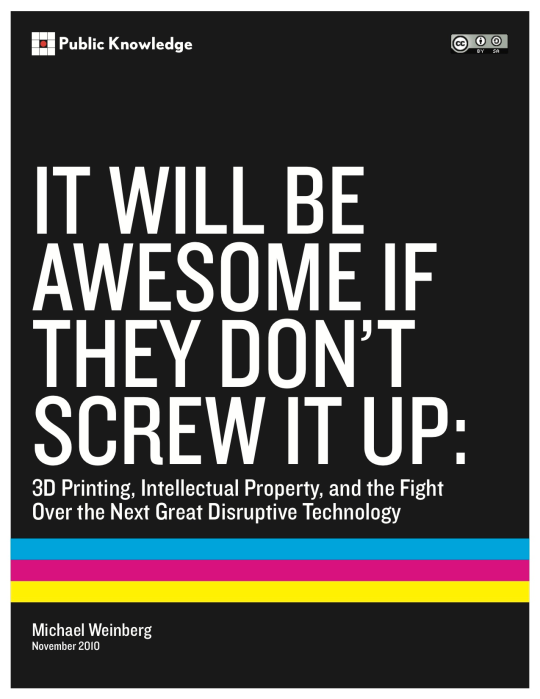
Five years ago today Public Knowledge published our first 3D printing whitepaper called “It Will Be Awesome if They Don’t Screw it Up: 3D Printing, Intellectual Property, and the Fight Over the Next Great Disruptive Technology.” It was our attempt to take Public Knowledge’s expertise in intellectual property and apply it to the then-emerging world of 3D printing. Alex Curtis had been pushing Public Knowledge to look into 3D printing for a while, and Simon Bradshaw, Adrian Bowyer, and Patrick Haufe, released their paper on 3D printing and IP earlier that year. Thanks to a jury duty-enforced light work load for the summer of 2010, I got to beat Alex to the punch and write the PK paper essentially porting the EU and UK legal analysis from the Bradshaw/Bowyer/Haufe paper to US law.
At the time neither Public Knowledge institutionally nor I personally knew a lot of people in the 3D printing world directly. In an attempt to help the paper find an audience, as part of the whitepaper rollout I did a series of 6 brief interviews with people in the community who were nice enough to respond to my emails. To celebrate the five year anniversary of the paper, I’m going to repost these interviews today.
Taken as a collection, the interviews capture a moment in 3D printing history before it really hit the mainstream. It was moving there – 3D printing had been featured in the New York Times – but talking to anyone about 3D printing still required a level of filling-in-of-background before you could get to whatever you really wanted to discuss. These short discussions were mostly aimed at getting answers to a handful of questions: what are people doing today with 3D printing? What will it look like in 2, 3, or even 5 years? What does the market look like and how it is changing?
Re-listening to these interviews, it is disorienting – and more than a little bit humbling - to hear myself asking people the same types of questions that people ask me today. They serve as a good reminder that, no matter when it happens, many people work through a similar sequence of questions when they come into contact with 3D printing for the first time.
I think it is fair to say that this paper kicked off an interesting five years for me. Two more papers, countless blog posts, speaking opportunities, a quartet of 3D/DCs (one year we did an Open Source Hardware event instead), and ultimately a new job followed. That made it fun for me to listen to these again. Maybe they will be interesting to someone else as well. They don’t have any intro or outro music, so apologies in advance for how abruptly the start and stop.
While I like each of these interviews, this is probably my
favorite. Professor Bowyer explains the
origins of the RepRap with biological metaphors that stick with me to this
day. His framing of the goals of the
RepRap project will make even the most cynical 3D printing veteran stop and
reflect on its success. On a more
practical level, I remember recording the entire interview under the threat of
a firewood delivery interrupting his side of the interview. Fortunately we wrapped up before the wood
arrived.
Michael recorded this interview from the stairwell of his offices at an architectural design firm in Kansas City. Shortly after this interview he moved to Brooklyn to work at Makerbot designing some truly amazing things. He’s now back in Kansas City working for Formlabs. Probably the most interesting part of this conversation is when he talks about the importance of design in expanding the scope of 3D printing and bringing in new designers and users.
Continuing the theme of awkward recording conditions, I’m pretty sure Bre recorded this entire interview standing in the middle of Union Square Park in Manhattan between meetings. What strikes me listening to this 5 years later is how comfortable being interviewed and enthusiastic about 3D printing he is. Listening to it, it is easy to believe how quickly Makerbot grew in the following years.
I met Andrew at the first Open Hardware Summit. He was an early leader in the RepRap community and was able to explain how the community came together and evolved. He, along with Rick Pollack, probably does the best job of capturing the mindset of that RepRap community at the end of 2010. For Andrew, it is from the perspective of those community members who saw themselves as pushing the limits of what the printers could do.
Then, as now, Rick is in charge of the desktop 3D printer company Makergear. If Andrew was on the user side of the RepRap community spectrum, Rick was on the vanguard of RepRap community members who were actively working to build a business in 3D printing. In his explanation of how he sees the role of Makergear, you can hear the founders of countless other entrepreneurs who have managed to bring 3D printing businesses to market.
It is striking how familiar Robert’s description of Shapeways feels today. We’re still working hard to be a place for designers and shopowners, and still pushing to make more materials available to more people. I’d like to think that Shapeways has taken big steps towards fulfilling the potential that he describes, while still being focused on improving what we offer all of our users.
Michael Weinberg
In pulling these together I found a description that I gave to the interview subjects about what Public Knowledge was doing in 3D printing and what these interviews are all about. It was accurate then and it still feels accurate today.